The lore of the sea and the legend of great battles have always captivated the imagination of generations since time immemorial. The first recorded naval war dates back to 1210 B.C. when the king of the Hitites, Suppiluliuma II defeated a fleet from Cyprus, and set their ships ablaze at sea. Throughout history many other battles were waged by the Assyrians, the Greeks, Persians, Europeans, Norse Vikings, Arabs, and nations of East and South Asia. Virtually every sea-faring nation which depended on the sea, rivers and its tributaries as the means to transport goods and raw materials, were prepared to fight to the death to defend their territorial rights. The past 3,000 years has seen a gradual naval arms race where battleships were built stronger, bigger, and faster, with more powerful weapons, eventually transforming from the elements of wood and wind to that of steel and steam.
World War I and World War Two set the stage for the last era in which famous battleships ruled the waves and when old empires of Great Britain and Germany clashed in epoch sea battles waged for the supremacy of the seas. The Battleships of old had great psychological impact - much like nuclear weapons of today.
Traditional doctrine required that a battleship be accompanied by a fleet of auxiliary vessels, such as battlecruisers, cruisers, destroyers, submarines, airships and aircraft, to scout for enemy vessels. But now the mission of scouting has been taken over by radio operators, direction finding, sonar, radar and traffic analysis. The cost of constructing and maintaining a fleet of battleships was so exorbitant that it met with more than a bit of controversy. In 1879, the French politician, Etienne Lamy wrote, "The construction of battleships is so costly, their effectiveness so uncertain and of such short duration, that the enterprise of creating an armored fleet seems to leave fruitless the perseverance of a people" In due time, the battleship was replaced by faster, long-range cruisers, torpedo boats, submarines, and the queen of naval warfare - the airplane.
Of the many technological innovations made during the two world wars, none made such a drastic impact on naval warfare as the development of the German U-boat, and that of the allied naval aircraft carriers. The Battleship was no longer the embodiment of sea power. Those which have survived the war have been made into museums.
Battle of the Atlantic Part 4: Battleships Blueprints and Specifications, is a tribute to the many grand dames of the sea, once powerful and stately, The following is the blueprint and specifications of the Bismarck, as well as those several cruisers, and one destroyer. These were the vessels that took part in the battles that ended with the sinking of the Bismarck. Needless to say, it would be impossible to mention all the ships here, so I have limited the list to a choice few. Though the Polish vessel ORP Piorun was not a battleship per se, but rather a destroyer, their participation in the hunt for the Bismarck earns them an Honourable mention. In fact, much more so, since they engaged in battle with the Bismarck for at least half an hour - an amazing David and Goliath story of the seas.
This is a memorial not only of warships but of the men who perished in the call of duty. As time passes, we may forget the battles, but we will always remember the men who fought with every ounce of sweat, blood and sinew. Their courage will never be forgotten.
BISMARCK
BUILDER
Builder: Blohm & Voss, Hamburg
CLASS AND TYPE
Bismarck Class
Battleship
LAID DOWN
1 July 1936
LAUNCHED
14 February 1939
COMMISSIONED
24 August 1940
CONSTRUCTION COST
RM. 196.8 million
DISPLACEMENT
Empty ship: 40,250 metric tons
Empty ship: 40,250 metric tons
Standard: 43,978 metric tons
Construction: 47,870 metric tons
Full load: 51,760 metric tons
Maximum: 53,486 metric tons
Construction: 47,870 metric tons
Full load: 51,760 metric tons
Maximum: 53,486 metric tons
DIMENSIONS
Waterline length: 241.55 meters
Overall length: 251 meters
Beam: 36 meters
Standard draught: 9.33 meters
Maximum draught: 10.55 meters
Freeboard amidships: between 4.45 - 5.67 meters
Height of hull sides (depth): 15 meters
Waterplane area: 5,740 m²
Waterline length: 241.55 meters
Overall length: 251 meters
Beam: 36 meters
Standard draught: 9.33 meters
Maximum draught: 10.55 meters
Freeboard amidships: between 4.45 - 5.67 meters
Height of hull sides (depth): 15 meters
Waterplane area: 5,740 m²
ARMOURED PROTECTION
Upper belt: 145 mm
Main belt: 320 mm
Main battery turrets: 130-360 mm
Secondary battery turrets: 40-100 mm
Upper deck: 50-80 mm
Third armour deck: 80-120 mm
Conning tower: 220-350 mm
Torpedo bulkhead: 45 mm
Main belt: 320 mm
Main battery turrets: 130-360 mm
Secondary battery turrets: 40-100 mm
Upper deck: 50-80 mm
Third armour deck: 80-120 mm
Conning tower: 220-350 mm
Torpedo bulkhead: 45 mm
Protected length: 70% (170.7 meters)
PC/TC: 17/22
Armour's weight: 19,082 metric tons
PC/TC: 17/22
Armour's weight: 19,082 metric tons
ARMAMENT
Main: 8 x 38cm/L52
Secondary: 12 x 15cm/L55
Anti-aircraft: 16 x 10.5cm/L65
16 x 3.7cm/L83
18 x 2cm/L65
FIRE CONTROL
5 x 10.5-m base rangefinders
1 x 7-m base rangefinder
2 x 6.5-m base rangefinders
4 x 4-m Type SL-8 rangefinders
2 x 3-m rangefinders
1 x 7-m base rangefinder
2 x 6.5-m base rangefinders
4 x 4-m Type SL-8 rangefinders
2 x 3-m rangefinders
RADAR EQUIPMENT
3 x FuMO 23
PROPULSION PLANT
12 Wagner boilers
Three Blohm & Voss turbine sets
150,170 hp (maximum obtained)
Three Blohm & Voss turbine sets
150,170 hp (maximum obtained)
SPEED
30.12 knots (maximum obtained)
ENDURANCE
9,280 nautical miles at 16 knots
8,900 nautical miles at 17 knots
8,525 nautical miles at 19 knots
6,640 nautical miles at 24 knots
4,500 nautical miles at 28 knots
8,900 nautical miles at 17 knots
8,525 nautical miles at 19 knots
6,640 nautical miles at 24 knots
4,500 nautical miles at 28 knots
FUEL CAPACITY
8,294 metric tons
AIRCRAFT
4 x Arado Ar 196
CREW
2,200+
Note:
2) PC/TC: Protected compartments / Total compartments. The protected compartments are those within the citadel.
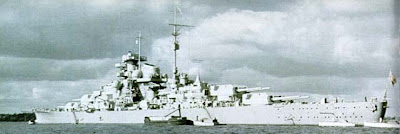 |
| BISMARCK in Kiel Harbour 1940 |
HMS HOOD
 | |
| HMS HOOD |
BUILDER
John Brown & Company
ORIGINAL COST
£6,025,000
CLASS & TYPE
Admiral-Class Battle Cruiser
LAID DOWN
September 1, 1916
LAUNCHED
August 22, 1918
COMMISSIONED
May 15, 1920
DISPLACEMENT
46,680 long tons (47,430 t) deep load
46,680 long tons (47,430 t) deep load
DIMENSIONS
Length: 860 ft 7 in (262.3 m)
Beam: 104 ft 2 in (31.8 m)
Draught: 32 ft 0 in (9.8 m)
ARMOURED PROTECTION
Belt: 12–6 in (305–152 mm)
Deck: 0.75–3 in (19–76 mm)
Barbettes: 12–5 in (305–127 mm)
Turrets: 15–11 in (381–279 mm)
Conning tower: 11–9 in (279–229 mm)
Bulkheads: 4–5 in (102–127 mm)
Deck: 0.75–3 in (19–76 mm)
Barbettes: 12–5 in (305–127 mm)
Turrets: 15–11 in (381–279 mm)
Conning tower: 11–9 in (279–229 mm)
Bulkheads: 4–5 in (102–127 mm)
PROTECTED LENGTH
65%
ARMAMENT (1941)
4 × 2 – 15-inch (381 mm) guns
7 × 2 – QF 4-inch Mk XVI AA guns
3 × 8 – QF 2-pdr “pom pom” AA guns
7 × 2 – QF 4-inch Mk XVI AA guns
3 × 8 – QF 2-pdr “pom pom” AA guns
5 × 4 – 0.5-inch Vickers machine guns
5 × 20-barrel "Unrotated Projectile" mounts
2 × 2 – 21-inch above water torpedo tubes
5 × 20-barrel "Unrotated Projectile" mounts
2 × 2 – 21-inch above water torpedo tubes
RADAR
1 x Type 284
1 x Type 279M
1 x Type 279M
AIRCRAFT
1 fitted 1931–32
1 catapult
1 catapult
MACHINERY
4 shafts
Brown-Curtis geared steam turbines
24 Yarrow water-tube boilers
Brown-Curtis geared steam turbines
24 Yarrow water-tube boilers
151,280 hp
INSTALLED POWER
144,000 shp (107,000 kW)
SPEED
1920: 31 knots (57 km/h; 36 mph)
1941: 28 knots (52 km/h; 32 mph)
1941: 28 knots (52 km/h; 32 mph)
ENDURANCE
5,950 nm at 18 knots
RANGE
1931: 5,332 nautical miles (9,870 km; 6,140 mi) at 20 knots (37 km/h; 23 mph)
FUEL CAPACITY
1,200 tons / 1219.3 MT of fuel oil
Maximum load was 4,000 tons / 4064.3 MT.
CREW
1,417
PENNANT NUMBER
51
MOTTO
Ventis Secundis
(Latin: "With Favourable Winds")
NICKNAME
Mighty Hood
CREW NICKNAME
"The Seven Bs"
"Britain's Biggest Bullsh*ttingest B*stard Built By Brown"
FATE
Sunk May 24, 1941
Sunk May 24, 1941
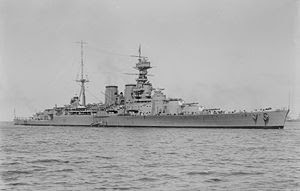 |
| HMS HOOD |
PRINZ EUGEN
 |
| USS Prinz Eugen |
CLASS & TYPE
Admiral Hipper-class
Heavy Cruiser
Heavy Cruiser
LAID DOWN
April 23, 1936
LAUNCHED
August 22, 1938
COMMISSIONED
August 1, 1940
DISPLACEMENT
Design: 16,970 t (16,700 long tons; 18,710 short tons)
Design: Full load: 18,750 long tons (19,050 t)
DIMENSIONS
Overall length: 207.7 m (681 ft 5 in)
Beam: 21.7 m (71 ft 2 in)
Draft: Full load: 7.2 m (24 ft)
ARMOURED PROTECTION
Belt: 70 to 80 mm (2.8 to 3.1 in)
Armor deck: 20 to 50 mm (0.79 to 2.0 in)
Turret faces: 105 mm (4.1 in)
Armor deck: 20 to 50 mm (0.79 to 2.0 in)
Turret faces: 105 mm (4.1 in)
ARMAMENT
8 × 20.3 cm (8.0 in) guns
12 × 10.5 cm (4.1 in) guns
12 × 3.7 cm (1.5 in) guns
8 × 2 cm (0.79 in) guns (20×1)
6 × 53.3 cm (21 in) torpedo tubes
12 × 10.5 cm (4.1 in) guns
12 × 3.7 cm (1.5 in) guns
8 × 2 cm (0.79 in) guns (20×1)
6 × 53.3 cm (21 in) torpedo tubes
AIRCRAFT
3 aircraft
1 catapult
PROPULSION-MACHINERY
3 × Blohm & Voss steam turbines
3 × three-blade propellers
100,000 hp (75 MW)
3 × three-blade propellers
100,000 hp (75 MW)
SPEED
32 knots (59 km/h; 37 mph)
CREW
1,340
FATE
Towed to Kwajalein Atoll after nuclear weapons test.
Towed to Kwajalein Atoll after nuclear weapons test.
Capsized December 1946
 |
| USS PRINZ EUGEN |
KING GEORGE V
 |
| KING GEORGE V |
BUILDER
Vickers-Armstrong, Newcastle upon Tyne
CLASS & TYPE
King George V Class
Battleship
LAID DOWN
January 1, 1937
LAUNCHED
February 21, 1939
COMMISSIONED
December 11, 1940
DISPLACEMENT
42,200 tons (1941)
DIMENSIONS
Length: 745 ft (227 m)
Beam: 103 ft (31 m)
Draught: 32.6 ft (9.9 m)
ARMOURED PROTECTION
Main belt: 14.7 in (374 mm)
lower belt: 5.4 in (137 mm)
deck: up to 5.38 in (136 mm)
main turrets: 12.75 in (324 mm)
barbettes: 12.75 in (324 mm)
lower belt: 5.4 in (137 mm)
deck: up to 5.38 in (136 mm)
main turrets: 12.75 in (324 mm)
barbettes: 12.75 in (324 mm)
ARMAMENT
10 × BL 14-inch (360 mm) Mk VII guns
16 × QF 5.25-inch (133 mm) Mk I guns
64 × 2 pounder "pom-pom" (40 mm)
16 × QF 5.25-inch (133 mm) Mk I guns
64 × 2 pounder "pom-pom" (40 mm)
AIRCRAFT
4 Supermarine Walrus planes
1 double-ended catapult
MACHINERY
8 Admiralty three-drum small-tube boilers with superheaters
4 Parsons single-reduction geared turbines
4 three-bladed propellers, 14 ft 6 in diameter (4.42 m)
125,000 shp
4 Parsons single-reduction geared turbines
4 three-bladed propellers, 14 ft 6 in diameter (4.42 m)
125,000 shp
SPEED
28.0 knots (1941 trials)
RANGE
5400+ nm at 18 knots (11.9 tons/hour fuel bur
CREW
1,314 to 1,631
PENNANT NUMBER
41
FATE
Struck in 1957
Sold for scrap
 |
| HMS KING GEORGE V |
DKM SCHNARNHORST
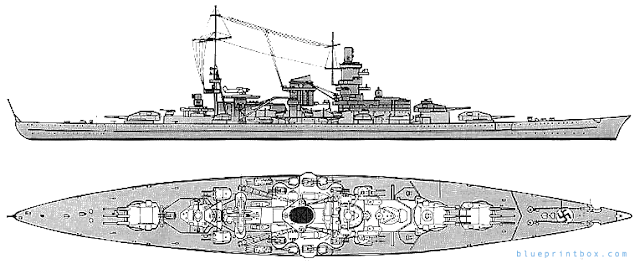 |
| DKM Scharnhorst |
BUILDER
Kriegsmarinewerft Wilhelmshaven
TYPE
Battleship – Battle Cruiser
LAID DOWN
June 15, 1935
LAUNCHED
October 3, 1936
COMMISSIONED
January 7, 1939
DISPLACEMENT
32,100 long tons (standard)
38,100 LT (full load)
38,100 LT (full load)
DIMENSIONS
Overall Length: 235 m (772 ft)
Waterline Length: 226 m (741.5 ft)
Waterline Length: 226 m (741.5 ft)
Beam: 30 m (98.4 ft)
Draught: 9.69 m (31 ft 9 in.) at 37,303 tons
ARMOURED PROTECTION
Belt: 350 mm (14 in)
Deck: 50 mm (2.0 in)
Turrets:200 to 360 mm (7.9 to 14 in)
Conning tower: 350 mm
Deck: 50 mm (2.0 in)
Turrets:200 to 360 mm (7.9 to 14 in)
Conning tower: 350 mm
ARMAMENT
9 × 28 cm/54.5 (11 inch) SK C/34
12 × 15 cm/55 (5.9") SK C/28
14 × 10.5 cm/65 (4.1 inch) SK C/33
16 × 3.7 cm/L83 (1.5") SK C/30
10 (later 16) × 2 cm/65 (0.79") C/30 or C/38
12 × 15 cm/55 (5.9") SK C/28
14 × 10.5 cm/65 (4.1 inch) SK C/33
16 × 3.7 cm/L83 (1.5") SK C/30
10 (later 16) × 2 cm/65 (0.79") C/30 or C/38
6 × 533 mm torpedo tubes
AIRCRAFT
3 Arado AR 196A
1 catapult
PROPULSION – MACHINERY
3 Germania/Brown, Boveri & Co geared turbines
3 three-bladed propellers, 4.8 m (15 ft 9 inch) diameter
151,893 shp
3 three-bladed propellers, 4.8 m (15 ft 9 inch) diameter
151,893 shp
SPEED
31 knots (57 km/h)
RANGE
7,100 nmi (13,100 km) at 19 kn (35 km/h)
CREW
1,613
FATE
Sunk at the Battle of North Cape
December 26, 1943
 |
| DKM SCHARNHORST |
HMS PRINCE OF WALES
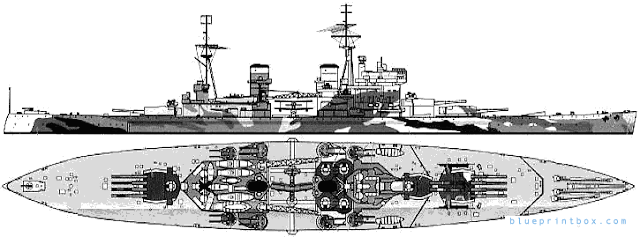 |
| HMS PRINCE OF WALES |
BUILDER
Cammell Laird and Company, Ltd., Birkenhead
CLASS & TYPE
King George V class
Battleship
LAID DOWN
January 1, 1937
LAUNCHED
May 3, 1939
COMMISSIONED
January 19, 1941
DISPLACEMENT
43,786 tons (deep)
DIMENSIONS
Overall Length: 745 ft 1 in (227.1 m)
Waterline Length: 740 ft 1 in (225.6 m)
Waterline Length: 740 ft 1 in (225.6 m)
Beam: 103 ft 2 in (31.4 m)
Draught: 34 ft 4 in (10.5 m)
ARMOURED PROTECTION
Main Belt: 14.7 inches (370 mm)
Lower belt: 5.4 inches (140 mm)
Deck: 5–6 inches (127–152 mm)
Main turrets: 12.75 inches (324 mm)
Barbettes: 12.75 inches (324 mm)
Bulkheads: 10–12 inches (254–305 mm)
Conning tower: 3–4 inches (76–102 mm)
Lower belt: 5.4 inches (140 mm)
Deck: 5–6 inches (127–152 mm)
Main turrets: 12.75 inches (324 mm)
Barbettes: 12.75 inches (324 mm)
Bulkheads: 10–12 inches (254–305 mm)
Conning tower: 3–4 inches (76–102 mm)
ARMAMENT
10 × BL 14-inch (360 mm) Mark VII
16 × QF 5.25-inch (133 mm) Mk. I
32 × QF 2 pdr 1.575-inch (40.0 mm) Mk.VIII
80x UP projectors
16 × QF 5.25-inch (133 mm) Mk. I
32 × QF 2 pdr 1.575-inch (40.0 mm) Mk.VIII
80x UP projectors
RADAR
Type 279 radar added
Type 284 radar added.
Radars added in May 1941.
4 x Type 282 and Type 285 radars added.
Radar added between June–July 1941.
Type 271 radar added.
Type 279 radar added
Type 284 radar added.
Radars added in May 1941.
4 x Type 282 and Type 285 radars added.
Radar added between June–July 1941.
Type 271 radar added.
AIRCRAFT
4 Supermarine Walrus seaplanes,
1 double-ended catapult
PROPULSION –MACHINERY
8 Admiralty 3-drum small-tube boilers
4 sets Parsons geared turbines
4 sets Parsons geared turbines
INSTALLED POWER
110,000 shp (82,000 kW)
SPEED
28.3 knots (52.4 km/h; 32.6 mph)
RANGE
15,600 nmi (28,900 km; 18,000 mi) at 10 knots (19 km/h; 12 mph)
CREW
1621-1941
PENNANT NUMBER
53
MOTTO
"Ich Dien" – German: "I serve"
FATE
Sunk on 10 December 1941
by Japanese air attack off Kuantan, South China Sea
 |
| HMS PRINCE OF WALES |
DKM GNEISENAU
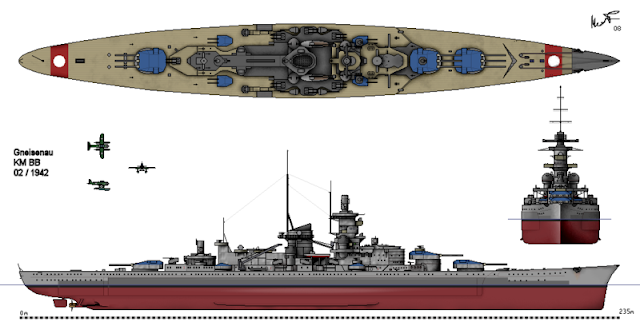 |
| DKM GNEISENAU |
BUILDER
Deutsche Werke
TYPE
Battleship - Battlecruiser
LAID DOWN
May 6, 1935
LAUNCHED
December 8, 1936
COMMISSIONED
May 21, 1938
DISPLACEMENT
32,100 long tons (standard)
38,100 LT (full load)
38,100 LT (full load)
DIMENSIONS
Overall Length: 235 m (772 ft)
Waterline Length: 226 m (741.5 ft)
Waterline Length: 226 m (741.5 ft)
Beam: 30 m (98.4 ft)
Draft: 9.69 m (31 ft 9 in.) at 37,303 tons
ARMOURED PROTECTION
Belt: 350 mm (14 in)
Deck: 50 mm (2.0 in)
Turrets:200 to 360 mm (7.9 to 14 in)
Conning tower: 350 mm
Deck: 50 mm (2.0 in)
Turrets:200 to 360 mm (7.9 to 14 in)
Conning tower: 350 mm
ARMAMENT
9 × 28 cm/54.5 (11 inch) SK C/34
12 × 15 cm/55 (5.9") SK C/28
14 × 10.5 cm/65 (4.1 inch) SK C/33
16 × 3.7 cm/L83 (1.5") SK C/30
10 (later 16) × 2 cm/65 (0.79") C/30 or C/38
12 × 15 cm/55 (5.9") SK C/28
14 × 10.5 cm/65 (4.1 inch) SK C/33
16 × 3.7 cm/L83 (1.5") SK C/30
10 (later 16) × 2 cm/65 (0.79") C/30 or C/38
6 × 533 mm torpedo tubes
AIRCRAFT
3 Arado Ar 196A
1 catapult
PROPULSTION – MACHINERY
3 Germania/Brown, Boveri & Co geared turbines
3 three-bladed propellers, 4.8 m (15 ft 9 inch) diameter
151,893 shp
3 three-bladed propellers, 4.8 m (15 ft 9 inch) diameter
151,893 shp
SPEED
31 kt
RANGE
6,200 nmi at 19 kn
CREW
1613 - 1669
FATE
Heavily damaged in an air raid 26–27 February 1942.
Decommissioned. Sunk as a blockship 23 March 1945.
Scrapped after the war.
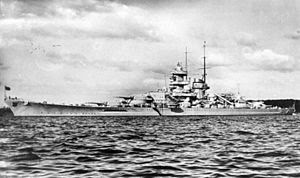 |
| DKM GNEISENAU |
HMS RODNEY
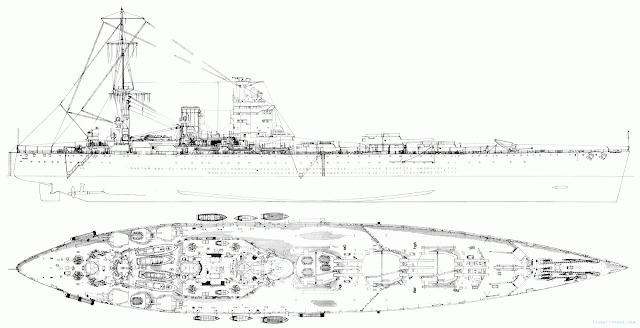 |
| HMS RODNEY |
Cammell, Laird, Birkenhead
ORIGINAL COST
£7,617,799
CLASS & TYPE
Nelson class Battleship
LAID DOWN
December 28, 1922
LAUNCHED
December 17, 1925
COMMISSIONED
November 10, 1927
DISPLACEMENT
33,730 long tons (34,270 t) standard
37,430 long tons (38,030 t) standard full load
37,430 long tons (38,030 t) standard full load
DIMENSIONS
Overall Length: 710 ft 2 in (216.5 m)
Beam: 106 ft (32.3 m)
Draught: 31 ft (9.44880000 m)
ARMOURED PROTECTION
Belt: 13–14 in (330–356 mm)
Deck: 4.375–6.375 in (111–162 mm)
Barbettes: 12–15 in (305–381 mm)
Gun turrets: 9–16 in (229–406 mm)
Conning tower: 10–14 in (254–356 mm)
Bulkheads: 4–12 in (102–305 mm)
Deck: 4.375–6.375 in (111–162 mm)
Barbettes: 12–15 in (305–381 mm)
Gun turrets: 9–16 in (229–406 mm)
Conning tower: 10–14 in (254–356 mm)
Bulkheads: 4–12 in (102–305 mm)
ARMAMENT
3 × 3 - 16-inch Mk I guns
6 × 2 - 6-inch Mk XXII guns
6 × 2 - 6-inch Mk XXII guns
6 × 1 - QF 4.7-inch Mk VIII anti-aircraft guns
8 × 1 - 2-pounder anti-aircraft guns
2 × 1 - 24.5-inch (620 mm) torpedo tubes
8 × 1 - 2-pounder anti-aircraft guns
2 × 1 - 24.5-inch (620 mm) torpedo tubes
PROPULSION –MACHINERY
2 shafts
2 Brown-Curtis geared turbine sets
8 Admiralty 3-drum oil-fired boilers
2 Brown-Curtis geared turbine sets
8 Admiralty 3-drum oil-fired boilers
INSTALLED POWER
45,000 shp (34,000 kW)
SPEED
23 knots (43 km/h; 26 mph)
RANGE
14,500 nmi (26,900 km; 16,700 mi) at 10 knots (19 km/h; 12 mph)
CREW
1,314 -1,361
PENNANT NUMBER
29
MOTTO
Non Generant Aquilae Columbas
"Eagles do not breed doves"
"Eagles do not breed doves"
NICKNAME
Rodnol
FATE
Sold for scrap, 26 March 1948
 |
| HMS RODNEY |
HMS DORSETSHIRE
 |
| HMS DORSETSHIRE |
BUILDER
Portsmouth Dockyard
CLASS & TYPE
County-class heavy cruiser
LAID DOWN
September 21, 1927
LAUNCHED
January 29, 1929
COMMISSIONED
September 30, 1930
DISPLACEMENT
10,035 long tons (10,196 t) (standard)
13,420 long tons (13,640 t) (full load)
13,420 long tons (13,640 t) (full load)
DIMENSIONS
Length: 632 ft 9 in (192.86 m)
Beam: 66 ft (20 m)
Draught: 18 ft (5.5 m)
ARMAMENT
8 × 8 in (200 mm) Mk VIII guns
8 × 4 in (100 mm) dual purpose guns
24 × 2-pounder pom-pom anti-aircraft guns
8 × 24 in (610 mm) torpedo tubes
numerous light anti-aircraft guns
8 × 4 in (100 mm) dual purpose guns
24 × 2-pounder pom-pom anti-aircraft guns
8 × 24 in (610 mm) torpedo tubes
numerous light anti-aircraft guns
AIRCRAFT
2 × Supermarine Walrus floatplanes
(operated by 700 Naval Air Squadron)
1 catapult
PROPULSION – MACHINERY
4 × Parsons geared or Brown Curtis steam turbines
8 × boilers
4 × shafts
8 × boilers
4 × shafts
INSTALLED POWER
80,000 shp (60,000 kW)
SPEED
31.5 kn (58.3 km/h; 36.2 mph)
RANGE
12,000 nmi (22,000 km; 14,000 mi) at 12 kn (22 km/h; 14 mph)
CREW
653
FATE
Sunk by IJN aircraft, 5 April 1942
 |
| HMS DORSETSHIRE |
ORP PIORUN
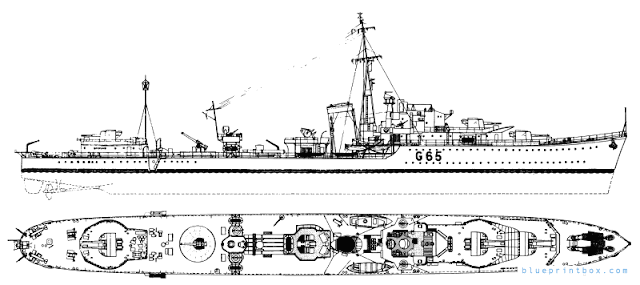 |
| ORP PIORUN |
BUILDER
John Brown Shipbuilding & Engineering Company Ltd.
(Clydebank, Scotland)
ORIGINAL COST
£400,963.16s
(excluding the cost of ammunition and equipment)
CLASS & TYPE
Class N
Destroyer
LAID DOWN
July 26, 1939
LAUNCHED
May 7, 1940
COMMISSIONED
November 4, 1940
FORMER NAME
HMS NERISSA
PENNANT NUMBER
G65
FATE
While under Polish command she had steamed 218,000 miles and given noble service to the allied cause. After two years laid-up at Harwich she was transferred to the Reserve Fleet Division at Sheerness and later in 1953 joined the Reserve Fleet at Chatham. Although selected for conversion to a Type 16 Anti-Submarine Frigate, this was never undertaken and in 1954 she was moved to Hartlepool to be laid-up. Placed on the Disposal List in May 1955 she was sold to BISCO for demolition in September, and towed to Dunston on Tyne where she arrived at the Clayton & Davie Ltd for breaking-up on 2nd December that year. (source: www.naval-history.net)FATE
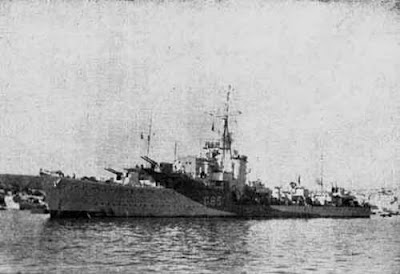 |
| ORP PIORUN (Polish Navy) |
ALLIED LOSSES
BATTLE OF THE ATLANTIC
1939
222 ships sunk (114 by submarine)
222 ships sunk (114 by submarine)
1940
1059 ships sunk (471 by submarine)
1941
1328 ships sunk (432 by submarine)
1942
1661 ships sunk (1159 by submarine)
1328 ships sunk (432 by submarine)
1942
1661 ships sunk (1159 by submarine)
1943
597 ships sunk (463 by submarine)
597 ships sunk (463 by submarine)
1944
247 ships sunk (132 by submarine)
1945
105 ships sunk (56 by submarine)
BATTLE OF ATLANTIC 4-part series
Part 1 TERROR ON THE HIGH SEAS
Part 2 THE WOLF PACK
Part 3 HUNT FOR THE BISMARCK
(Click on previous articles)
Recommended links:


